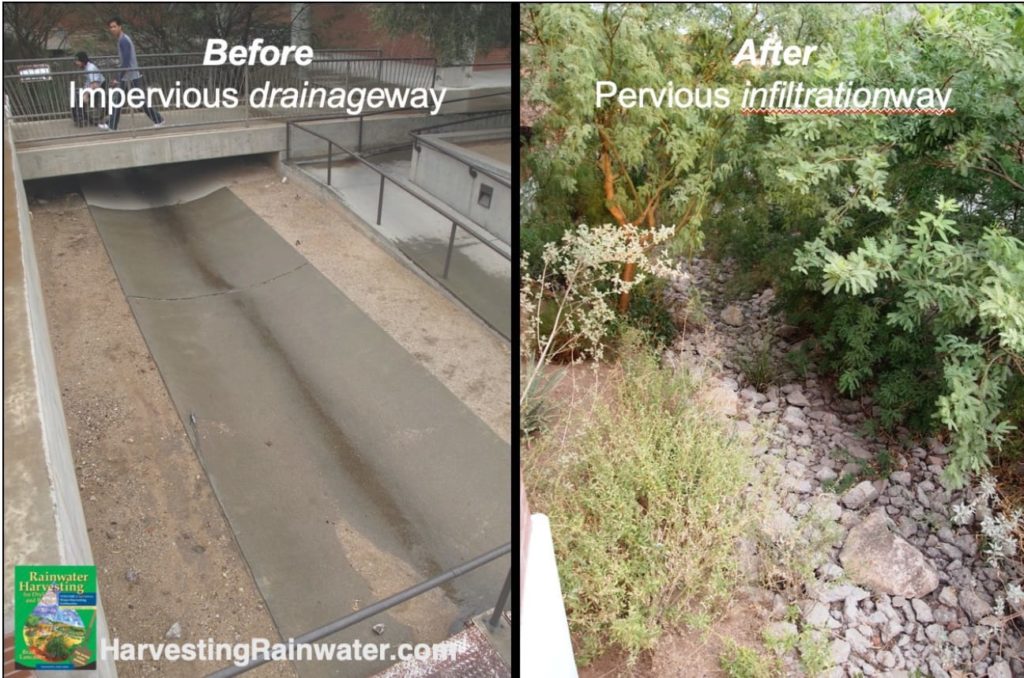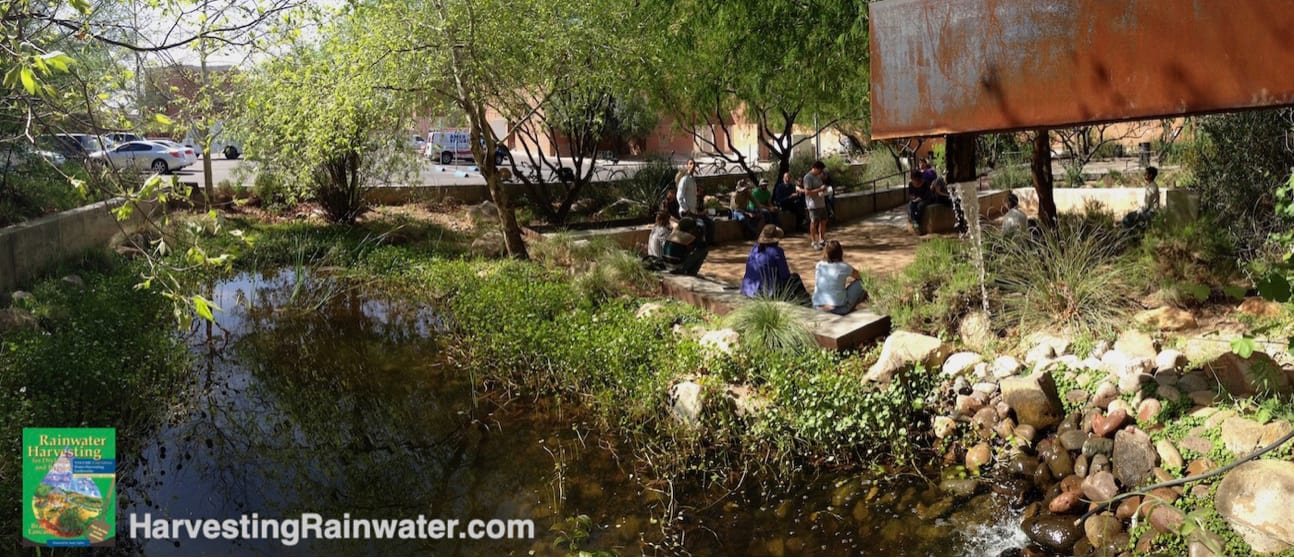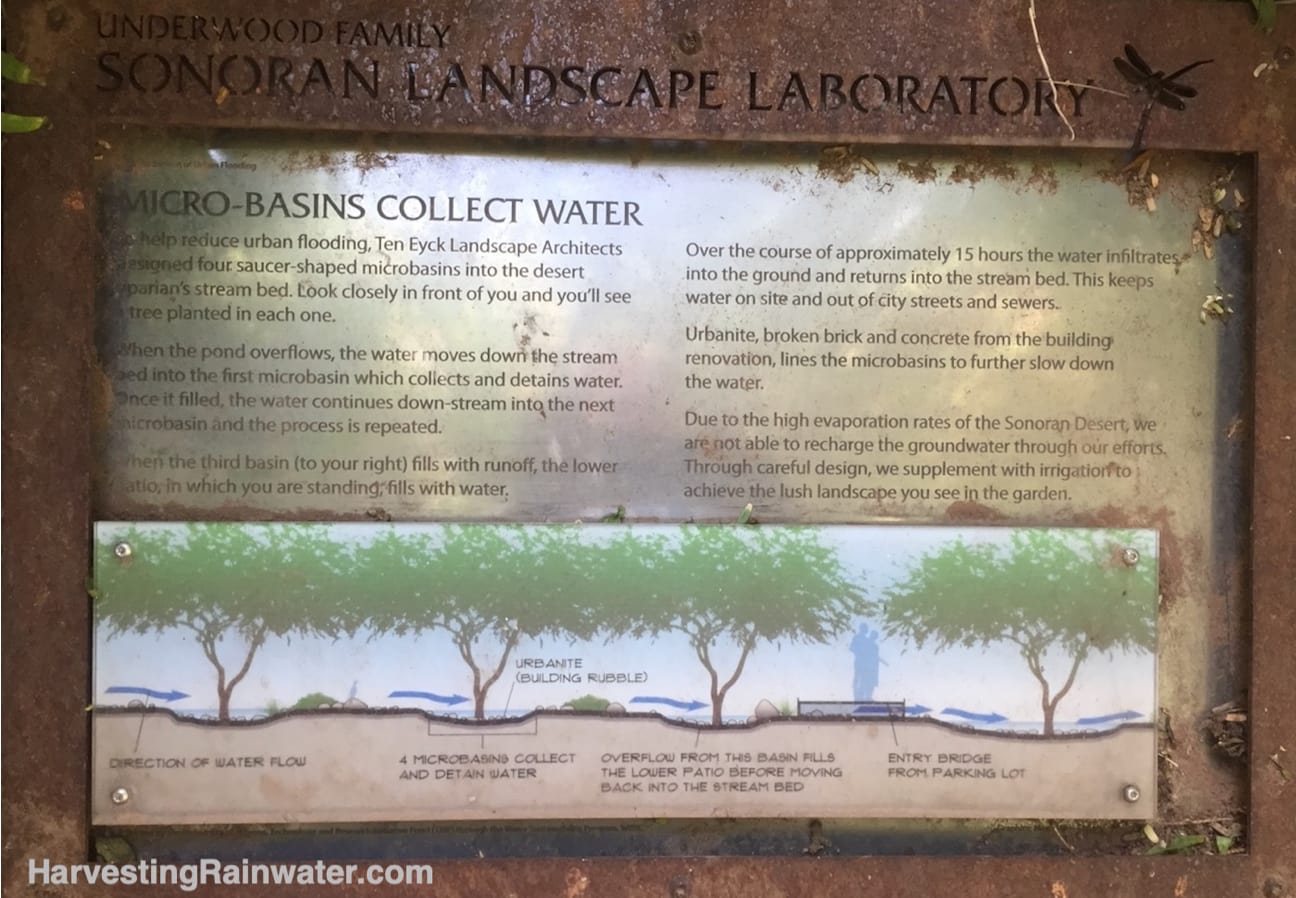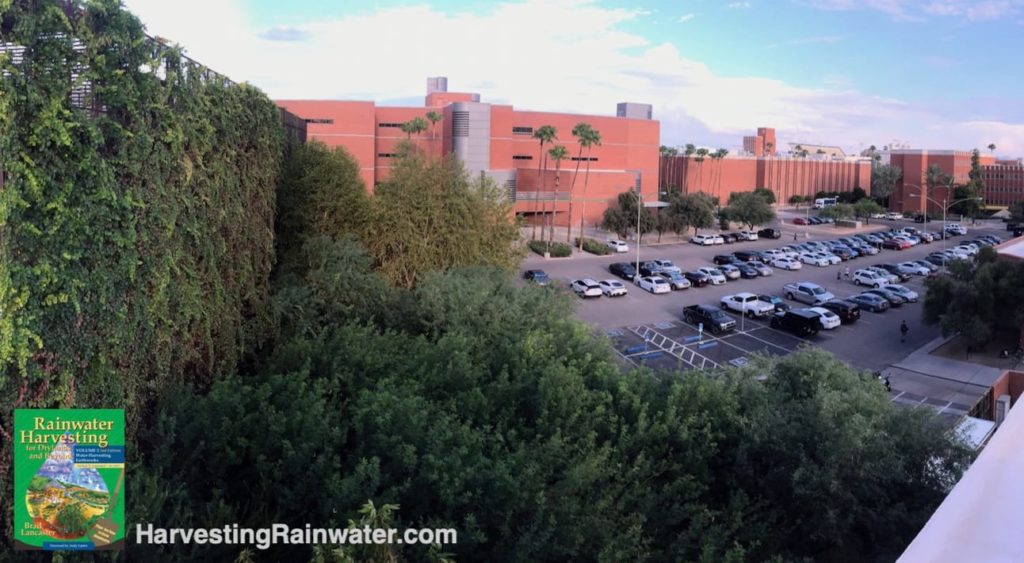Underwood Family Sonoran Landscape Laboratory at the College of Architecture, Planning, and Landscape Architecture (CAPLA) at the University of Arizona
A beautiful installation harvesting rainwater, roof runoff, air conditioning condensate, drinking fountain greywater, and well backwash water to provide 83 to 87% of the lush landscape’s irrigation demand (though read on to see how they could tweak the system to easily provide 100% of irrigation demand solely with free on-site waters). Five biomes of the Sonoran Desert are represented within the landscape.

Photos: Brad Lancaster
The following is reproduced with permission from “Rainwater Harvesting for Drylands and Beyond, Volume 2, 2nd Edition” by Brad Lancaster:
The Underwood Family Sonoran Landscape Laboratory at the University of Arizona is one of my favorite oases in the built environment. It was designed by Ten Eyck Landscape Architects and is located on the south and east sides of the College of Architecture, Planning, and Landscape Architecture (CAPLA) building. Leaving the exposed solar oven-like parking lot, you walk into a cool sanctuary of living classrooms and hang out spots beneath a canopy of abundant shade trees and diverse life. And all this is supported almost entirely by “waste” water utilized as “resource” waters harvested from adjoining buildings.
On average, 85,000 gallons (322,000 liters) of rainwater a year enters the landscape from the roofs of adjoining buildings. More surprisingly, 95,000 gallons (360,000 liters) of air conditioning condensate a year comes to the landscape from the HVAC (heating, ventilation and air conditioning) units on these roofs, despite Tucson’s dry climate. The perspiring, respiring bodies of many students and professors inhabiting the buildings increase the moisture in the recirculating air, which the HVAC systems capture.
Additionally, the landscape harvests backwash water from the daily maintenance of an adjoining sand filter well (about 200 gallons [760 liters] per day) and greywater from the building’s drinking fountains. Sink greywater is not captured because students doing studio design projects might unconsciously pour toxic solvents, paints, or glues down sink drains.
An 11,600-gallon (43,900-liter) cistern captures some of these waters, while the rest—along with overflow from the cistern—is captured by a small pond and arroyo-like swale meandering through much of the landscape.

Photo: Brad Lancaster, 3-2014

Photo: Brad Lancaster
Five biomes of the Sonoran Desert—wetland, canyon, riparian, mesquite bosque, and upland Sonoran—are represented by microclimate groupings of native plant species. Endangered Gila topminnows and lowland leopard frogs are raised in the wetland’s pond. Great blue herons, roadrunners, and hawks visit to partake of the bounty. Students can eat wild grapes, chuparosa flowers, and mesquite pods grown within the landscape.
Part of the vision of this biosponge-like landscape was to illustrate a new way of landscaping, creating a model for how to transform the campus and regional landscaping. Former associate dean Dr. Ron Stoltz, who oversaw the project, wants to see the parking lot south of the CAPLA landscape transformed into the second-largest green space on campus, irrigated solely by discarded waters from adjoining rooftops, hardscapes, air conditioners, and greywater drains. Just look to the CAPLA landscape to see how this could work.

A canyon.
Just as the CAPLA landscape on the left has been transformed into a verdant urban canyon, so the adjacent parking lot could be transformed to a biosponge oasis irrigated with water harvested from the surrounding buildings (mesa tops) and hardscape.
Photo: Brad Lancaster, 8-2018
Potential improvements
Most of the landscape’s water needs (83 to 87%) are met by the harvest of free on-site “waste” waters turned “resource” waters.
But how could 100% of the water needs be met with free, on-site waters?
Ask yourself, and try to answer before reading potential solutions below…
- Reduce water needs—replace a few high-water-use plants, such as an Arizona sycamore, with a lower-water-use tree.
- Increase water supply—direct more runoff surfaces, such as a parking lot or another roof, to the landscape.
- More efficiently slow, spread, and sink (infiltrate) the water within the landscape…
– Direct cistern overflow to the highest point of the landscape (currently it’s directed to the midpoint), which can then overflow to—and help irrigate—all points below.
– Create higher-capacity, organic-matter mulched basins within the swale and upland Sonoran biome to increase the amount of moisture captured in the soil before overflow water escapes.
– Utilize vertical mulching within basins (see chapter 7 of Rainwater Harvesting for Drylands and Beyond, Volume 2, 2nd Edition for more info).
– Make sure all (or at least more of the) planted area are sunken, not raised; so they harvest and hold rain, other on-site waters, and leaf drop and other nutrient-rich organic matter.
– Utilize organic-matter mulch (such as compost, wood chips, cut up prunings, and leaf drop) instead of rock and gravel mulch in areas harvesting direct rainfall, but through which stormwater does not flow. Unlike rock and gravel, the organic mulch feeds and supports more soil life (such as burrowing earthworms and bugs), which then quickens the rate of water infiltration into the soil, while also holding onto that soil moisture longer into the dry seasons.
Additional potential improvements
- Tucson Basin-native velvet mesquite trees would have been a better choice than the South-American hybrid mesquite trees used, as the native species offer far more wildlife habitat value (supporting five times as many native pollinators), have better tasting mesquite pods (for people too), and have more stable root systems so they don’t heave pavement and the trees don’t blow over. (Many of the hybrid mesquites are cabled to the ground because they are susceptible to blowing over in strong winds).
- Still more food-producing Tucson native plant species and diversity could’ve been incorporated into the landscape (there are over 400 food plants native to the Sonoran Desert).
Video tour
For more information on the Underwood Family Sonoran Landscape Laboratory see here
Where:
1040 N. Olive Road, Tucson, AZ 85721-0075
Hours: always open
Cost: free
This location is included in the following tours:
See the new, full-color, revised editions of Brad’s award-winning books
– available a deep discount, direct from Brad:

Volume 1
This book is used in a number of the CAPLA classes, and is the primary textbook for the Rainwater Harvesting class at the University of Arizona.

Volume 2
This book is used in a number of the CAPLA classes, and is the secondary textbook for the Rainwater Harvesting class at the University of Arizona.
